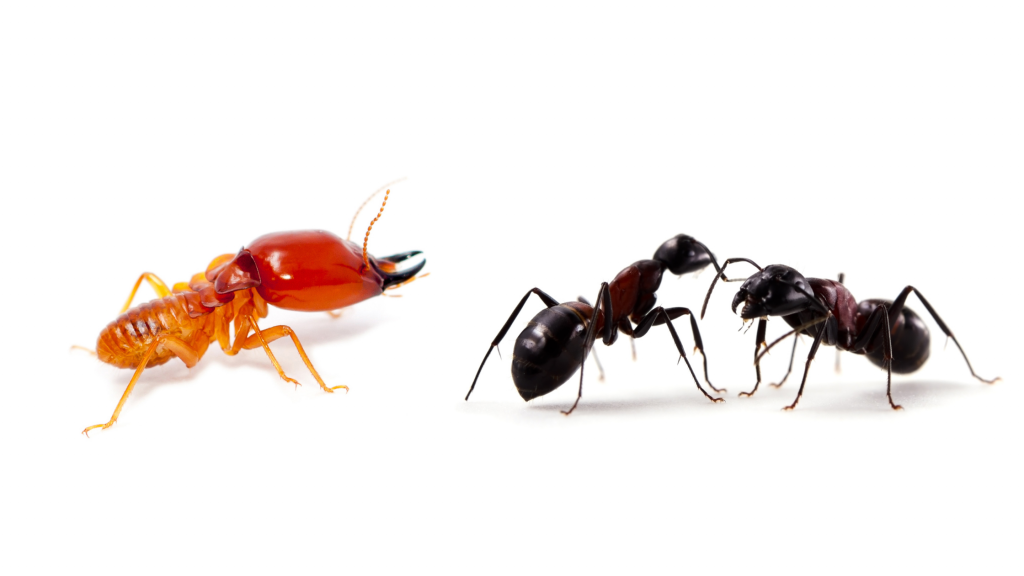
Termites vs Ants
Ants are one of the easiest pests to identify and are found anywhere and everywhere – including parks, outside of stores, sidewalks, and your backyard. Despite being so common, they are often confused with termites. Ants and Termites look so similar that you will need to understand their differences to properly identify them.
Appearance
Ants are commonly identified by their narrow waist, bent antennae, and three distinct body sections. Their colors include black, red, brown, orange, and multiple varieties of these colors combined. While some ants also have wings, there are two pairs of wings, with the front being bigger than the hind.
Termites have a broad “rectangular” waist that looks like two different body sections: the head and the body. Their antennae are straight and their two pairs of wings are the same size, just bigger than their body. Termites also come in a variety of colors such as creamy white, dark brown, black, or a mix of these colors together. A big difference compared to ants is worker and soldier termites either have small or no eyes and reproductive termites have compound eyes.
Life Cycle
Ants undergo complete metamorphosis, transforming through multiple stages from young larvae to full-grown adults. These stages include:
- Egg – Tiny, oval, white, or translucent. They are laid by the queen and hatch after 1-2 weeks
- Larva – Worm-like larvae that are taken care of by the worker ants until the next stage. They depend on them to be fed and cared for and this can last for several weeks to months.
- Pupa – Enclosed in cocoons, larvae undergo metamorphosis to become adults. This stage can last weeks to months.
- Adult – Once they emerge from the pupa stage, they are full-grown adults. They then go into different roles within their colonies, including queens, workers, and drones – males that reproduce with the queen
During a termite’s life cycle, they go through an incomplete metamorphosis. The different stages include:
- Egg – Small, oval, white, or translucent eggs that last several weeks in this stage.
- Nymph – Nymphs resemble smaller versions of adults and go through many different molts, to shed their exoskeleton and grow larger. It can take several months to years depending on the species to fully grow into an adult.
- Adult – After the last molt, the termite is now a full-grown adult. They then go into different roles that include workers, soldiers, reproductives, queens, and kings.
Behaviors
Ants live in an organized system within their colony consisting of the queen, males, and workers. The workers are sterile females who work foraging for food, taking care of the young, protecting the colony, and many other duties. They are found in various environments building their nests in soil, wood, or plants and forming visible mounds, as well as having a wide range diet of sugary substances, proteins, and fats. Ants will be visibly seen and will bite or sting if their colony is disturbed. The workers will also usually live up to a few months maximum. The male drones die right after they mate, and the queen can live up to 10 years.
The ant that is commonly confused with a termite is a carpenter ant. The way to tell if it truly is a carpenter ant is by looking for tunnels that are created as they travel through wood and leave wood shavings behind. Ants do not feed on the wood, like Termites do.
Termites live in a complex system in their colonies, consisting of kings and queens, soldiers, and workers, and can get more complex than just this. Queens can live up to 25-30 years with kings having a bit of a shorter life span than queens, and workers and soldiers being able to live up to 1-2 years. The whole colony depends on the soldiers to protect it from predators, and soldiers depend on the workers. They build their nests within wood structures or underground, sometimes being so large they end up forming above-ground mounds.
All termites will avoid light and rarely be noticed unless the nest is disturbed. The tunnels that they form are rough, ragged, and filled with layers of soil and mud. Termites will chew and eat through healthy wood and will cause significant wood damage. This wood is also what they primarily feed on in their diet as well as plant matter.
Preventions
Learn about some prevention tips that will help both termites and ants!
- Maintain cleanliness – Remove food sources that attract pests and make sure to seal containers airtight. Additionally, sweeping floors after cooking, wiping down counters, and maintaining every room in your home will reduce pest food sources.
- Maintain outdoor spaces – Trimming down trees away from your home, and keeping plants trimmed away will help reduce areas that pests are attracted to. Keep firewood stacks away and if able to, keep it in an enclosed container.
- Professional help – Having professional help is crucial! With our service for termites, we offer a 24/7 monitoring service and do inspections semi-annually. With ants, we can provide treatment and truly target their egg cycles to ensure your home is being kept pest-free.
With this information, we hope you better understand the key differences between termites and ants. Do you have any activity for either ants or termites? Let us help you and contact our office at (844)572-0628 with our effective services!
